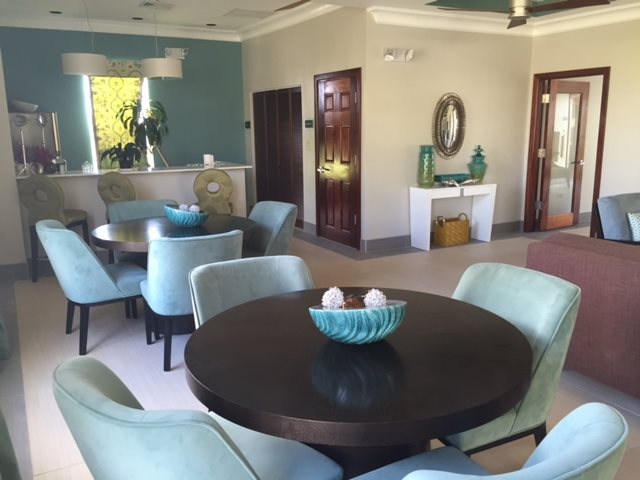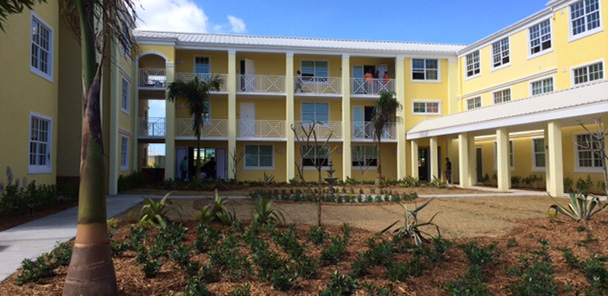FREDERIKSTED — McCormack Baron Salazar faces long delays in completing a 100-unit affordable-housing project here because the Big Island was hard hit by Hurricane Maria.
But it’s up in the air whether the St. Louis developer’s insurance will cover it for these delays. If they were caused by physical damage, it likely wouldn’t be an issue.
But that’s not the problem. McCormack Baron faces months of delays because the Virgin Island’s labor force has been depleted by evacuations and demand for immediate repair work.
Does the firm’s insurance cover that? “That’s one of the issues we’re working through right now,” said Vincent Bennett, McCormack Baron’s president.
His company McCormack Baron built the Louis E. Brown Villas in Estate Paradise. Their groundbreaking was this year.
Every natural disaster presents a unique set of challenges for insurance companies and real-estate owners and developers. But insurance executives and property owners say that the back-to-back hurricanes that hit the Caribbean this year left in their wake unprecedented challenges that will keep lawyers, accountants and appraisers busy for years.
The thorniest cases are likely to involve so-called business-interruption claims resulting from broad regional problems like labor shortages, long-term damage to power grids and moribund tourism industries. These policies typically reimburse landlords and other business owners for lost revenue during the time it takes to fix hurricane damage, like flooded power rooms or busted roofs.
There’s also the potential for claims because this tourist season has been a washout on many of the hard-hit islands. “If nobody is going to, for example, Anguilla then what revenues would a hotel have generated absent any damage to its property?” said Paul Isaac, partner at U.K.-based forensic accountants Matson Driscoll & Damico UK LLP, which is working with clients in the Caribbean to assess claims.
The challenge facing the insurance industry stems partly from the scale of the devastation. Hurricanes Irma and Maria are expected to cause insured losses of as much as $135 billion to the Caribbean islands and the U.S., including Puerto Rico, according to catastrophe modeling firm AIR Worldwide. By comparison, the costliest prior hurricane world-wide was Hurricane Katrina in 2005, which resulted in insured losses of more than $60 billion at the time, according to 2015 data by Munich Re .
Insurance industry representatives say so far the process of settling claims has been going relatively well. “The insurance companies are prepared to take these claims on,” said Tom Fitzgerald, chief executive of Aon Global Broking, an insurance broker.
Still, the number and size of hurricanes this year has been tough for the insurance industry. Widespread power problems in the region’s infrastructure and recovery efforts are slowing the damage-assessment process creating a logjam of claims, insurance executives say.
“We’re still in the stage currently where it goes back and forth between the insured and the insurance company,” Rutte said.
One concern is about potential widespread emigration from say, Puerto Rico to mainland U.S., which could make it difficult for businesses on the island to restart their operations fully even if their properties have been repaired. “There is a possibility that is claimed under a business-interruption loss,” said Tom Sabbatelli, a hurricane risk expert at catastrophe modeling firm RMS.
Some are predicting years of litigation. “This is going to be one of the biggest insurance fights maybe in the history of the United States,” said Wes Farrell, an attorney at Farrell, Patel, Jomarron & Lopez, which has a branch in Puerto Rico.
Lawyers and insurance-industry executives say that policies vary greatly when it comes to business interruption. After property damage is repaired, “there can be a whole host of reasons that you can’t operate,” said Linda Kornfeld, vice chair of insurance recovery for law firm Blank Rome. “Some of those reasons are covered. Some of those reasons, you have to get creative to get them covered.”
Kornfeld said there’s a famous case in the insurance industry of two planes belonging to two different carriers that were both delayed during the aftermath of the Sept. 11 terrorist attacks. “Both lost a lot of money,” she said. “One of the insurance policies was written in such a way that there was coverage for the exact same thing that wasn’t covered under the other airline’s insurance policy.”
Lawyers and insurance-industry executives say that the lessons learned and legal precedents set in the aftermath of the hurricane season of 2017 will likely be incorporated into policies in the future. “There’s no question the litigation that comes out of this spate of hurricanes is going to be different from prior litigation,” Kornfeld said.


